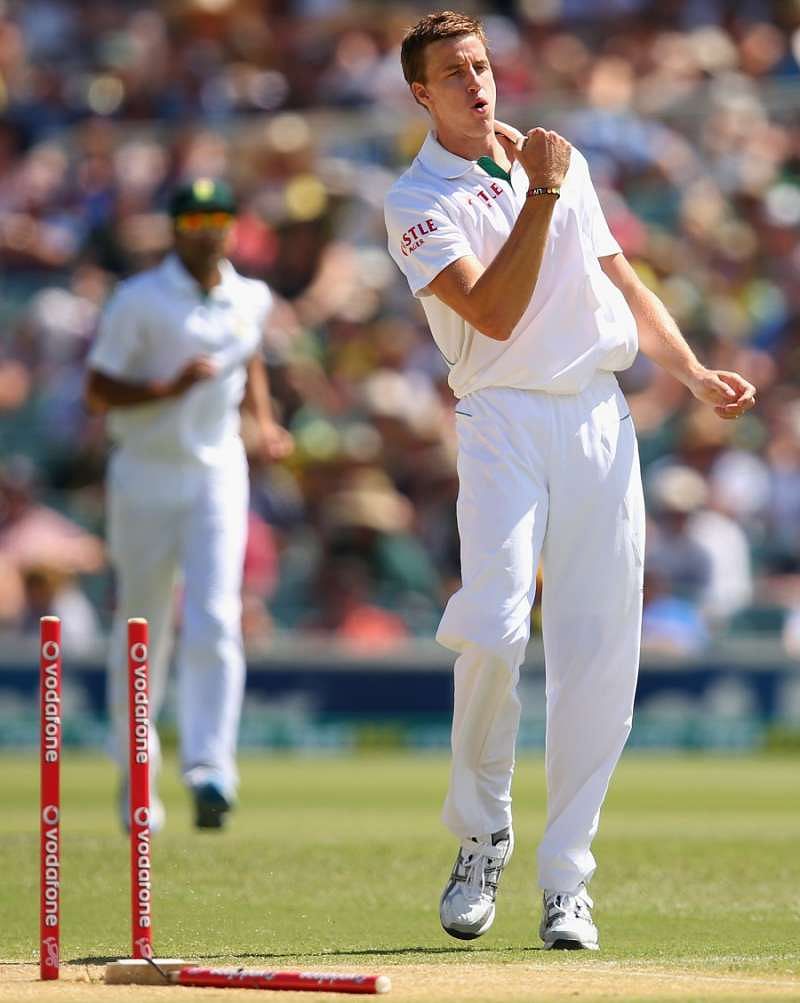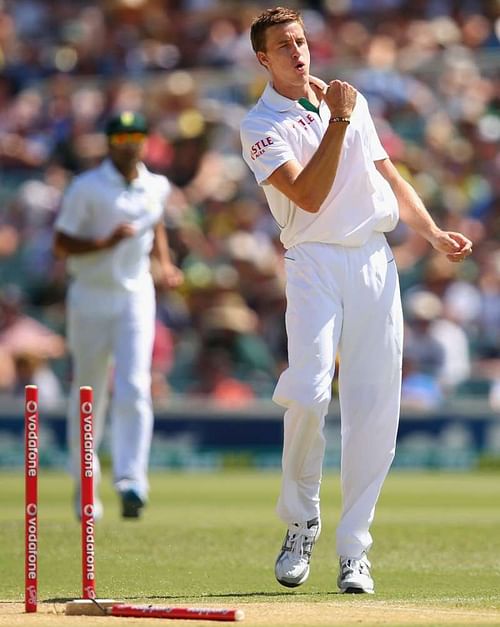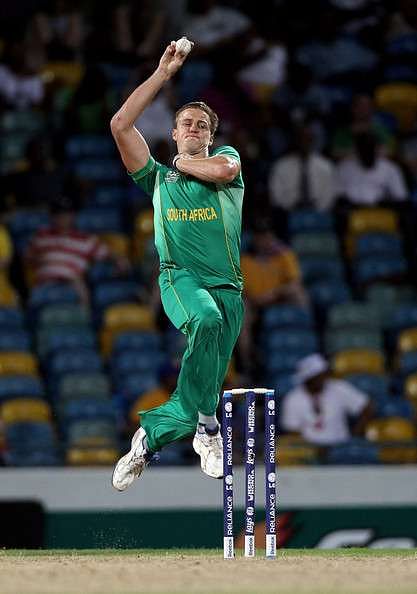
Morne Morkel - Quiet achiever of the Proteas' pace battery
There is a great delight in watching a fearsome Dale Steyn knocking out the off stumps of the batsmen with his ultra-fast inswinging yorkers or forcing the batsmen to edge his fast-paced outswingers. Steyn can bowl intimidating bouncers too and possesses all the attributes of a complete fast bowler.
His awe-inspiring record will always be followed with unblinking eyes by all cricket lovers and will be dissected by cricket statisticians with great zeal in the coming years. He went past 400 test wickets and is well on his way to surpassing the legendary Glenn McGrath’s record tally of 563 test wickets and becoming the first ever pace bowler in the history to claim 600 test wickets.
Amidst all this pomp, ‘Steyn’s second-in-command’ – Morne Morkel’s contribution to the South African pace attack, which is not as colossal as Steyn’s, but definitely very significant has largely gone under the radar. Since his test debut in 2006, Morkel played second fiddle to Steyn and did it in a remarkable way.
While Steyn has been the undisputed leader of the South African pace attack over the years, Morkel has been his great deputy. Steyn is a darling of the crowd but Morkel certainly deserves more credit and recognition for his bowling achievement than what he had got so far.
Steyn-Morkel duo resembles the legendary English pace bowling duo of Fred Trueman, widely known as ‘Fiery Fred’ and Brian Statham of the 1950s. While Trueman was more lethal and terrified the batsmen, Statham was a gentle assassin who bowled with amazing accuracy. Trueman, who became the first bowler in the history to claim 300 test wickets, was the record-breaking bowler of the duo and Statham always had to live under the shadow of Trueman and came second, although he was a very efficient operator himself.
Steyn, like Trueman, is the record-breaker with a slew of records under his belt while Morkel grew slowly but steadily under Steyn’s shadow. Morkel’s name will eternally be linked with that of Steyn just as Statham’s will be with Trueman’s. Steyn has been playing the lead role while Morkel has been a great supporting actor. Therefore, it is apt to say that Morkel was to Steyn what Statham was to Trueman.
Interestingly, there is another point of similarity between Morkel and Statham – the no. of test matches played and wickets taken. A brief comparison of the stats of the bowling of Morkel and Statham in tests –
| Player | Matches | Wickets | Average | Strike Rate |
| Brian Statham | 70 | 252 | 24.84 | 63.7 |
| Morne Morkel (till mid-2016) | 71 | 242 | 29.33 | 56.3 |
At this point of time, Morkel played 71 test matches and took 242 wickets which means he played almost the same number of matches Statham played and took only ten wickets less than what the great Statham could manage in his test career. Morkel’s relatively higher bowling average is compensated by his lower bowling Strike Rate.
Like Steyn, Morkel too can hit the 140 kmph mark consistently; a pace that can send shivers down the spines of the not-so-accomplished batsmen and that can pose a serious challenge to even top-notch batsmen on any surface. Morkel lacks Steyn’s ability to generate prodigious swing while bowling at a scorching pace. His modus operandi is not filled with mysteries and is a very simple one.
He is more of ‘hit the deck’ variety, very much in the mould of Jason Gillespie. He runs in hurriedly and hits the turf hard. Like many great fast bowlers like Glenn McGrath and Curtly Ambrose, Morkel is blessed with a very tall frame which he uses to great advantage. He is six feet six inches tall which enables him to deliver the ball from a great height and thus extract great bounce regardless of the nature of the pitch.
It is not unusual to see many of Morkel’s deliveries falling just a few yards in front of the batsmen but rising viciously from there and meeting the bat or the wicket-keeper’s gloves at a considerable height. While Morkel relies heavily on his bounce to get the better of the batsmen, he is far from being a one-trick pony.
He can bedevil the batsmen with his yorkers and normal full-length deliveries too. Here is a video showing how Shikhar Dhawan, the Indian opening batsman fell victim to an unplayable yorker by Morkel in a test match. Dhawan had absolutely no answer!!
While discussing Morkel, a comparison with Steyn is inevitable. So, let us now see how he fares when compared to his illustrious partner, Dale Steyn in both test and ODI cricket.
Dale Steyn vs Morne Morkel in tests
| Player | Matches | Wickets | Average | Strike Rate |
| Dale Steyn | 82 | 406 | 22.53 | 41.7 |
| Morne Morkel | 71 | 242 | 29.33 | 56.3 |
Be it average or Strike Rate or any other parameter of bowling, Steyn wins hands down over Morkel. Morkel’s tally of 242 wickets in 71 matches is outshone by Steyn’s whopping 406 wickets in 82 matches. On an average, Steyn picks up almost five wickets per match which is an incredible feat, considering the fact there are only a handful of bowlers in the entire history of the game who played a large number of test matches and took wickets at a faster rate.
To be fair to Morkel, Steyn’s test match numbers are so outstanding that they can put to shade the statistics of any other contemporary pace bowler and that of many great pace bowlers in the history too. As long as Morkel’s stats in tests are viewed in conjunction with that of Steyn, they appear far less impressive than they really are but when viewed in isolation, one can easily realize that Morkel’s tally too is a significant one and is worthy of more plaudits than it actually received so far.
It is fair to say that Morkel has been a wonderful support bowler for Steyn and ensured that Steyn was not overbowled or overburdened. While four wickets per match is considered as the benchmark for bowling greatness, there are a few notable exceptions to it such as Bob Willis, an England great who snaffled 325 wickets in 90 matches. By the time Morkel hangs up his boots in test cricket, he is most likely to fall into that category.
Dale Steyn vs Morne Morkel in ODIs
| Player | Matches | Wickets | Average | Runs Per Over (RPO) | Strike Rate |
| Morne Morkel | 108 | 181 | 24.60 | 4.95 | 29.7 |
| Dale Steyn | 112 | 175 | 25.93 | 4.86 | 32.0 |
The numbers clearly demonstrate that Morkel enjoyed far greater success in ODIs than in tests. While Steyn towers over Morkel in tests, the difference in their ODI bowling stats is very small. In fact, Morkel’s stats are marginally superior to that of Steyn. Morkel’s wicket-taking rate per match is 1.67(181 wickets/108 matches) is better than Steyn’s wicket-taking rate of is 1.56 (175 wickets/112 matches). Coming to Strike Rate, Morkel (29.7) has a healthy lead of two full points over Steyn (32.0).
While there is not much to choose between the two in ODIs, one has to say that Morkel gave Steyn a run for his money in ODIs and even managed to rack up slightly more impressive numbers during the course. This is in stark contrast to tests where Morkel’s impressive tally was easily overshadowed by Steyn’s eye-popping numbers.
Morne Morkel vs other leading ODI pace bowlers of the same generation
The significance of Morkel’s exploits in ODIs can be best understood when his numbers are compared against those of other leading pace bowlers of the same generation. Barring James Anderson and Lasith Malinga who made their debut in ODIs in 2002 and 2004 respectively, all other bowlers mentioned in the below table entered the ODI fray between 2005 and 2007, the same time during which Morkel made his debut.
Greats like Brett Lee who played a decent amount of ODI cricket in the latter half of the last decade, had to be omitted from consideration as they are too senior to Morkel to be classified as being of the same generation.
| Player | Matches | Wickets | Economy | Strike Rate | Average | Wickets per match ( No. of wickets / No. of matches ) |
| Morne Morkel | 108 | 181 | 4.95 | 29.7 | 24.60 | 1.67 |
| Dale Steyn | 112 | 175 | 4.86 | 32.0 | 25.93 | 1.56 |
| Mitchell Johnson | 153 | 239 | 4.83 | 31.3 | 25.26 | 1.56 |
| Lasith Malinga | 191 | 291 | 5.26 | 31.6 | 27.77 | 1.52 |
| James Anderson | 194 | 269 | 4.92 | 35.6 | 29.22 | 1.38 |
| Stuart Broad | 121 | 178 | 5.26 | 34.3 | 30.13 | 1.47 |
The primary job of a bowler, especially if he is a frontline bowler like Morkel and not a part-timer is to take wickets. So, it is safe to consider the ‘no. of wickets taken per match’ as the single most important parameter while evaluating a bowler’s effectiveness. On this count, Morkel leads the pack of the aforementioned top pace bowlers with a magnificent 1.67 ‘wickets per match’ which means he bettered even the more attractive breed of pace bowlers like Johnson, who can be intimidating with his scorching pace and Malinga, who has a great reputation for bringing the batsmen to his knees with his unplayable yorkers.
Another crucial point to note is that Morkel is the only one in the list with a Strike Rate of less than 30 and average of less than 25. In spite of this, the phrase ‘very very serious threat’ has not been associated with Morkel as frequently as it has been linked with a bowler like Malinga or Steyn. Morkel is the sort of bowler who gets on with his business quietly and excels in his role without drawing too much attention to him.
This is an era in which grounds are getting smaller and smaller, bats are growing fatter and fatter and rules are becoming more and more batsmen-friendly. All these factors contributed to the swelling of economy rates of the bowlers and made any economy rate of less than 5 seem perfectly reasonable. So, Morkel conceding 4.95 runs per over on an average is not something that can be held against him and is even worthy of appreciation.
In limited overs cricket, Morkel is a consummate professional and there are not many pace bowlers of his calibre at the moment.
Where will Morkel finish in the pantheon of the South African greats?
Morkel will turn 32 on October 6th and he is entering the twilight of his career. If his body does not give in and his performance does not drop, he will have a good 3-4 years of cricket left in him. The rise of Vernon Philander means that there is one more quality pace bowler apart from Steyn with whom Morkel will have to share the spoils.
The emergence of youngsters like Kasigo Rabada will keep Morkel on his toes. Steyn will continue to be the spearhead till he retires. By the time Morkel calls it a day, he will have booked a place for himself in the pantheon of the South African all-time bowling greats right below the names of Allan Donald, Dale Steyn and Shaun Pollock. After all, reaching anywhere near those illustrious names is a remarkable feat by any standards.
Morkel is younger than Steyn and hence is likely to continue playing for a year or two after the latter retires. Probably, Morkel’s achievements will then shine more brightly and he will hog the limelight that has eluded him so far.
While we all revel in Steyn’s breathtaking feats, let us never forget that there is one more man in the same pace battery who played a crucial role in the phenomenal success of the Proteas. Morkel certainly deserves a lot more laurels to be showered upon him. Let us celebrate the feats of Morkel too, the quiet achiever from South Africa who has not been given his due in today’s cricket.

